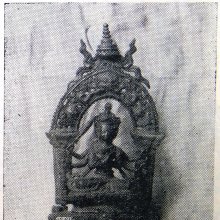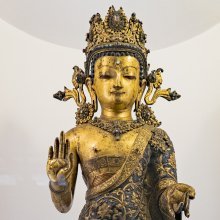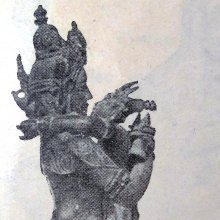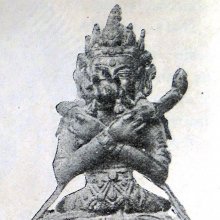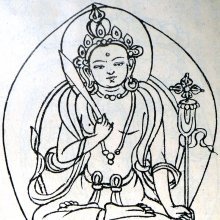Adibuddha, Ādibuddha, Adi-buddha: 6 definitions
Introduction:
Adibuddha means something in Buddhism, Pali, Hinduism, Sanskrit. If you want to know the exact meaning, history, etymology or English translation of this term then check out the descriptions on this page. Add your comment or reference to a book if you want to contribute to this summary article.
Images (photo gallery)
(+2 more images available)
In Buddhism
Tibetan Buddhism (Vajrayana or tantric Buddhism)
Source: archive.org: The Indian Buddhist IconographyĀdibuddha (आदिबुद्ध) (in Vajrayāna) is regarded as the highest deity of the Buddhist pantheon, the originator even of the five Dhyāni Buddhas. When represented in human form, he begets the name of Vajradhara and is conceived in two forms, single and Yab-yum. When single, he is bedecked in jewels, gaudy ornaments and dress, sits in the Vajraparyaṅka or the attitude of meditation with the two feet locked with soles of the feet turned upwards. He carries the Vajra in the right hand and the Ghaṇṭā (bell) in the left, the two hands being crossed against the chest in what is known as the Vajrahuṅkāra-mudrā. The Vajra (thunderbolt) here is the symbol for the ultimate reality called Śūnya while the bell represents Prajñā or wisdom the sounds of which travel far and wide.
Source: Brill: Śaivism and the Tantric Traditions (tantric Buddhism)Ādibuddha (आदिबुद्ध) refers to “one who is awakened from the very beginning”, according to the Nāmamantrārthāvalokinī by Vilāsavajra, which is a commentary on the Nāmasaṃgīti.—Accordingly, [while commenting on verse 100ab]—“{Ādi-buddha}: [the word] ādibuddha means [he who is] ‘awakened from the very beginning’, and that one has the five gnoses as his nature (pañcajñāna-ātmaka). [...] So that one, who has the five gnoses as his nature and [also] the five colours as his nature, is the lord. And he should be understood to be Mañjuśrī, since as the equality of all dharmas he is the unique ground [of all phenonena]. For that very reason he is [described as] free from [causal] connection”.
Note: Ādibuddha may be rendered in English by “Original Buddha” and denotes a figure seen as the embodiment of the gnosis (jñāna) underlying the state of Buddhahood. It is not surprising, perhaps, that Mañjuśrī, as the Bodhisattva of wisdom par excellence, would be reconfigured to function additionally as the Ādibuddha.

Tibetan Buddhism includes schools such as Nyingma, Kadampa, Kagyu and Gelug. Their primary canon of literature is divided in two broad categories: The Kangyur, which consists of Buddha’s words, and the Tengyur, which includes commentaries from various sources. Esotericism and tantra techniques (vajrayāna) are collected indepently.
Languages of India and abroad
Sanskrit dictionary
Source: DDSA: The practical Sanskrit-English dictionaryĀdibuddha (आदिबुद्ध).—a. perceived in the beginning.
-ddhaḥ the primitive Buddha.
Ādibuddha is a Sanskrit compound consisting of the terms ādi and buddha (बुद्ध).
Source: Cologne Digital Sanskrit Dictionaries: Monier-Williams Sanskrit-English Dictionary1) Ādibuddha (आदिबुद्ध):—[=ādi-buddha] [from ādi] mfn. ‘perceived in the beginning’
2) [v.s. ...] m. Name of the chief deity of the northern Buddhists.
[Sanskrit to German]
Sanskrit, also spelled संस्कृतम् (saṃskṛtam), is an ancient language of India commonly seen as the grandmother of the Indo-European language family (even English!). Closely allied with Prakrit and Pali, Sanskrit is more exhaustive in both grammar and terms and has the most extensive collection of literature in the world, greatly surpassing its sister-languages Greek and Latin.
See also (Relevant definitions)
Ends with: Appadibuddha.
Full-text (+97): Guhyeshvari, Adinatha, Svayambhucaitanya, Svabhava, Svayambhu, Parinishpanna, Caturbuddhasana, Asanayoga, Candramandala, Caturbuddha, Sarvadharmasamata, Niranvaya, Varnatmaka, Pancashikha, Pancaciraka, Ekalambanatva, Alambanatva, Pancanana, Pancamukha, Alambana.
Relevant text
Search found 14 books and stories containing Adibuddha, Ādibuddha, Adi-buddha, Ādi-buddha; (plurals include: Adibuddhas, Ādibuddhas, buddhas). You can also click to the full overview containing English textual excerpts. Below are direct links for the most relevant articles:
The gods of northern Buddhism (by Alice Getty)
The Indian Buddhist Iconography (by Benoytosh Bhattachacharyya)
Figure 12 - Ādi-Buddha, Vajradhara (from a Nepalese painting)
Figure 66 - Bodhisattva Mañjuśrī
The Catu-Bhanavara-Pali (critical study) (by Moumita Dutta Banik)
Paritta and Tantra < [Chapter 1 - Introduction]
(8) Atanatiya-sutta < [Chapter 4 - Subject Matter of the Third Bhanavara]
Mandukya Upanishad (by Kenneth Jaques)
Verse 92 < [Chapter 4]
Lakulisha-Pashupata (Philosophy and Practice) (by Geetika Kaw Kher)
Goraksanatha and Natha Sampradaya < [Chapter 2 - Spread and Transition]
Chenian Short Lectures in America (by Yogi C. M. Chen)
Chapter 2 - The Three Identifications < [Part One]
Chapter 3 - Some Questions Answered < [Part Two]
.jpg)
